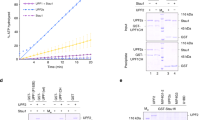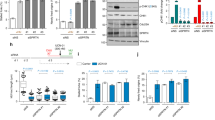Abstract
Staufen1 (STAU1)-mediated mRNA decay (SMD) degrades mammalian-cell mRNAs that bind the double-stranded RNA (dsRNA)-binding protein STAU1 in their 3′ untranslated region. We report a new motif, which typifies STAU homologs from all vertebrate classes, that is responsible for human STAU1 (hSTAU1) homodimerization. Our crystal structure and mutagenesis analyses reveal that this motif, which we named the Staufen-swapping motif (SSM), and the dsRNA-binding domain 5 ('RBD'5) mediate protein dimerization: the two SSM α-helices of one molecule interact primarily through a hydrophobic patch with the two 'RBD'5 α-helices of a second molecule. 'RBD'5 adopts the canonical α-β-β-β-α fold of a functional RBD, but it lacks residues and features required to bind duplex RNA. In cells, SSM-mediated hSTAU1 dimerization increases the efficiency of SMD by augmenting hSTAU1 binding to the ATP-dependent RNA helicase hUPF1. Dimerization regulates keratinocyte-mediated wound healing and many other cellular processes.
This is a preview of subscription content, access via your institution
Access options
Subscribe to this journal
Receive 12 print issues and online access
$189.00 per year
only $15.75 per issue
Buy this article
- Purchase on Springer Link
- Instant access to full article PDF
Prices may be subject to local taxes which are calculated during checkout







Similar content being viewed by others
References
Gautrey, H., McConnell, J., Lako, M., Hall, J. & Hesketh, J. Staufen1 is expressed in preimplantation mouse embryos and is required for embryonic stem cell differentiation. Biochim. Biophys. Acta 1783, 1935–1942 (2008).
Martel, C., Macchi, P., Furic, L., Kiebler, M.A. & DesGroseillers, L. Staufen1 is imported into the nucleolus via a bipartite nuclear localization signal and several modulatory determinants. Biochem. J. 393, 245–254 (2006).
Miki, T., Takano, K. & Yoneda, Y. The role of mammalian Staufen on mRNA traffic: a view from its nucleocytoplasmic shuttling function. Cell Struct. Funct. 30, 51–56 (2005).
Dugré -Brisson, S et al. Interaction of Staufen1 with the 5′ end of mRNA facilitates translation of these RNAs. Nucleic Acids Res. 33, 4797–4812 (2005).
Chatel-Chaix, L., Abrahamyan, L., Frechina, C., Mouland, A.J. & DesGroseillers, L. The host protein Staufen1 participates in human immunodeficiency virus type 1 assembly in live cells by influencing pr55Gag multimerization. J. Virol. 81, 6216–6230 (2007).
Chatel-Chaix, L., Boulay, K., Mouland, A.J. & DesGroseillers, L. The host protein Staufen1 interacts with the Pr55Gag zinc fingers and regulates HIV-1 assembly via its N-terminus. Retrovirology 5, 41 (2008).
Gong, C., Kim, Y.K., Woeller, C.F., Tang, Y. & Maquat, L.E. SMD and NMD are competitive pathways that contribute to myogenesis: effects on PAX3 and myogenin mRNAs. Genes Dev. 23, 54–66 (2009).
Kim, Y.K., Furic, L., DesGroseillers, L. & Maquat, L.E. Mammalian Staufen1 recruits Upf1 to specific mRNA 3′UTRs so as to elicit mRNA decay. Cell 120, 195–208 (2005).
Kim, Y.K. et al. Staufen1 regulates diverse classes of mammalian transcripts. EMBO J. 26, 2670–2681 (2007).
Gong, C. & Maquat, L.E. lncRNAs transactivate STAU1-mediated mRNA decay by duplexing with 3′ UTRs via Alu elements. Nature 470, 284–288 (2011).
Cho, H. et al. Staufen1-mediated mRNA decay functions in adipogenesis. Mol. Cell 46, 495–506 (2012).
Maquat, L.E. & Gong, C. Gene expression networks: competing mRNA decay pathways in mammalian cells. Biochem. Soc. Trans. 37, 1287–1292 (2009).
Micklem, D.R., Adams, J., Grunert, S. & St Johnston, D. Distinct roles of two conserved Staufen domains in oskar mRNA localization and translation. EMBO J. 19, 1366–1377 (2000).
St Johnston, D., Brown, N.H., Gall, J.G. & Jantsch, M. A conserved double-stranded RNA-binding domain. Proc. Natl. Acad. Sci. USA 89, 10979–10983 (1992).
Wickham, L., Duchaîne, T., Luo, M., Nabi, I.R. & DesGroseillers, L. Mammalian staufen is a double-stranded-RNA- and tubulin-binding protein which localizes to the rough endoplasmic reticulum. Mol. Cell Biol. 19, 2220–2230 (1999).
Duchaîne, T. et al. A novel murine Staufen isoform modulates the RNA content of Staufen complexes. Mol. Cell Biol. 20, 5592–5601 (2000).
Luo, M., Duchaîne, T.F. & DesGroseillers, L. Molecular mapping of the determinants involved in human Staufen-ribosome association. Biochem. J. 365, 817–824 (2002).
Allison, R. et al. Two distinct Staufen isoforms in Xenopus are vegetally localized during oogenesis. RNA 10, 1751–1763 (2004).
Duchaîne, T.F. et al. Staufen2 isoforms localize to the somatodendritic domain of neurons and interact with different organelles. J. Cell Sci. 115, 3285–3295 (2002).
Park, E., Gleghorn, M.L. & Maquat, L.E. Staufen2, like Staufen1, functions in SMD by binding to itself and its paralog and promoting UPF1 helicase but not ATPase activity. Proc. Natl. Acad. Sci. USA 110, 405–412 (2013).
Furic, L., Maher-Laporte, M. & DesGroseillers, L. A genome-wide approach identifies distinct but overlapping subsets of cellular mRNAs associated with Staufen1- and Staufen2-containing ribonucleoprotein complexes. RNA 14, 324–335 (2008).
Ramos, A. et al. RNA recognition by a Staufen double-stranded RNA-binding domain. EMBO J. 19, 997–1009 (2000).
Tian, B., Bevilacqua, P.C., Diegelman-Parente, A. & Mathews, M.B. The double-stranded-RNA–binding motif: interference and much more. Nat. Rev. Mol. Cell Biol. 5, 1013–1023 (2004).
Stefl, R. et al. The solution structure of the ADAR2 dsRBM-RNA complex reveals a sequence-specific readout of the minor groove. Cell 143, 225–237 (2010).
Martel, C. et al. Multimerization of Staufen1 in live cells. RNA 16, 585–597 (2010).
Thompson, J.D., Higgins, D.G. & Gibson, T.J. CLUSTAL W: improving the sensitivity of progressive multiple sequence alignment through sequence weighting, position-specific gap penalties and weight matrix choice. Nucleic Acids Res. 22, 4673–4680 (1994).
Marchler-Bauer, A. et al. CDD: a Conserved Domain Database for the functional annotation of proteins. Nucleic Acids Res. 39, D225–D229 (2011).
Holm, L. & Rosenstrom, P. Dali server: conservation mapping in 3D. Nucleic Acids Res. 38, W545–W549 (2010).
Gan, J. et al. A stepwise model for double-stranded RNA processing by ribonuclease III. Mol. Microbiol. 67, 143–154 (2008).
Buchan, D.W. et al. Protein annotation and modelling servers at University College London. Nucleic Acids Res. 38, W563–W568 (2010).
Jones, D.T. Protein secondary structure prediction based on position-specific scoring matrices. J. Mol. Biol. 292, 195–202 (1999).
Gong, C. & Maquat, L.E. “Alu”strious long ncRNAs and their role in shortening mRNA half-lives. Cell Cycle 10, 1882–1883 (2011).
Ravel-Chapuis, A. et al. The RNA-binding protein Staufen1 is increased in DM1 skeletal muscle and promotes alternative pre-mRNA splicing. J. Cell Biol. 196, 699–712 (2012).
Amoutzias, G.D., Robertson, D.L., Van de Peer, Y. & Oliver, S.G. Choose your partners: dimerization in eukaryotic transcription factors. Trends Biochem. Sci. 33, 220–229 (2008).
Cho, D.S. et al. Requirement of dimerization for RNA editing activity of adenosine deaminases acting on RNA. J. Biol. Chem. 278, 17093–17102 (2003).
Valente, L. & Nishikura, K. RNA binding-independent dimerization of adenosine deaminases acting on RNA and dominant negative effects of nonfunctional subunits on dimer functions. J. Biol. Chem. 282, 16054–16061 (2007).
Cole, J.L. Activation of PKR: an open and shut case? Trends Biochem. Sci. 32, 57–62 (2007).
Barraud, P. et al. An extended dsRBD with a novel zinc-binding motif mediates nuclear retention of fission yeast Dicer. EMBO J. 30, 4223–4235 (2011).
Fuerstenberg, S., Peng, C.Y., Alvarez-Ortiz, P., Hor, T. & Doe, C.Q. Identification of Miranda protein domains regulating asymmetric cortical localization, cargo binding, and cortical release. Mol. Cell Neurosci. 12, 325–339 (1998).
Schuldt, A.J. et al. Miranda mediates asymmetric protein and RNA localization in the developing nervous system. Genes Dev. 12, 1847–1857 (1998).
Haase, A.D. et al. TRBP, a regulator of cellular PKR and HIV-1 virus expression, interacts with Dicer and functions in RNA silencing. EMBO Rep. 6, 961–967 (2005).
Parker, G.S., Maity, T.S. & Bass, B.L. dsRNA binding properties of RDE-4 and TRBP reflect their distinct roles in RNAi. J. Mol. Biol. 384, 967–979 (2008).
Hitti, E.G., Sallacz, N.B., Schoft, V.K. & Jantsch, M.F. Oligomerization activity of a double-stranded RNA-binding domain. FEBS Lett. 574, 25–30 (2004).
Hall, T.A. BioEdit: a user-friendly biological sequence alignment editor and analysis program for Windows 95/98/NT. Nucl Acids Symp Ser 41, 95–98 (1999).
Philo, J.S. A method for directly fitting the time derivative of sedimentation velocity data and an alternative algorithm for calculating sedimentation coefficient distribution functions. Anal. Biochem. 279, 151–163 (2000).
Philo, J.S. Improved methods for fitting sedimentation coefficient distributions derived by time-derivative techniques. Anal. Biochem. 354, 238–246 (2006).
Schuck, P. Size-distribution analysis of macromolecules by sedimentation velocity ultracentrifugation and Lamm equation modeling. Biophys. J. 78, 1606–1619 (2000).
Stafford, W.F. & Sherwood, P.J. Analysis of heterologous interacting systems by sedimentation velocity: curve fitting algorithms for estimation of sedimentation coefficients, equilibrium and kinetic constants. Biophys. Chem. 108, 231–243 (2004).
Chen, V.B. et al. MolProbity: all-atom structure validation for macromolecular crystallography. Acta Crystallogr. D Biol. Crystallogr. 66, 12–21 (2010).
Acknowledgements
We thank H. Kuzmiak (University of Rochester) for generating pSTAU155(R)-HA3; L. DesGroseillers (Université de Montréal) for pSTAU155-HA3; K. Nehrke for microscope use; G. Pavlencheva and C. Hull for technical assistance; R. Singer (Albert Einstein College of Medicine) for pmRFP; S. de Lucas and J. Ortín (Centro Nacional de Biotecnología) for anti-STAU1; and J. Lary (University of Connecticut Analytical Ultracentrifugation Facility), J. Jenkins, J. Wedekind and M. Popp for helpful conversations. This work was made possible by US National Institutes of Health (NIH) grant NIH R01 GM074593 to L.E.M. M.L.G. was supported by a Ruth L. Kirschstein National Research Service Award (NRSA) NIHF32 GM090479 Fellowship and grant NIH NCI T32 CA09363. C.G. was supported by a Messersmith Graduate Student Fellowship. The University of Rochester Medical Center Structural Biology and Biophysics Facility is supported by NIH National Center for Research Resources (NCRR) grants 1S10 RR026501 and 1S10 RR027241, NIH National Institute of Allergy and Infectious Diseases (NIAID) grant P30 AI078498 and the University of Rochester School of Medicine and Dentistry. The Cornell High Energy Synchrotron Source (CHESS) is supported by the National Science Foundation (NSF) and NIH National Institute of General Medicine Sciences (NIGMS) through NSF award DMR-0225180. Macromolecular Diffraction at CHESS (MacCHESS) is supported by NIH NCRR RR-01646. The Stanford Synchrotron Radiation Lightsource (SSRL) Structural Molecular Biology Program is supported by the Department of Energy Office of Biological and Environmental Research, the NIH National Center for Research Resources Biomedical Technology Program (P41RR001209) and the NIGMS.
Author information
Authors and Affiliations
Contributions
M.L.G. and L.E.M. conceived the project and wrote the manuscript with input from C.L.K. Experiments were designed by M.L.G., C.G. and L.E.M. M.L.G. carried out the structural work with input from C.L.K., and designed and constructed the plasmids needed for this study. C.G. undertook experiments using cultured cells. All authors contributed to data interpretation.
Corresponding author
Ethics declarations
Competing interests
The authors declare no competing financial interests.
Supplementary information
Supplementary Text and Figures
Supplementary Figures 1–6, Supplementary Tables 1 and 2 and Supplementary Notes 1–3 (PDF 2245 kb)
Rights and permissions
About this article
Cite this article
Gleghorn, M., Gong, C., Kielkopf, C. et al. Staufen1 dimerizes through a conserved motif and a degenerate dsRNA-binding domain to promote mRNA decay. Nat Struct Mol Biol 20, 515–524 (2013). https://doi.org/10.1038/nsmb.2528
Received:
Accepted:
Published:
Issue Date:
DOI: https://doi.org/10.1038/nsmb.2528



